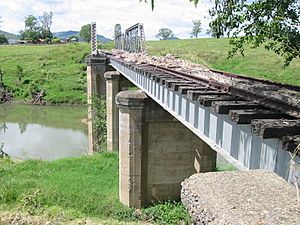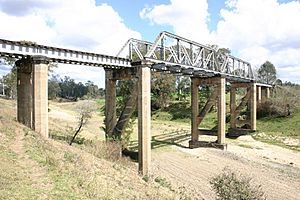Harlin Rail Bridge facts for kids
Quick facts for kids Harlin Rail Bridge |
|
|---|---|

Harlin Rail Bridge, 2011
|
|
| Location | over Ivory (formerly Maronghi) Creek, Harlin, Somerset Region, Queensland, Australia |
| Design period | 1900 - 1914 (early 20th century) |
| Built | 1910 |
| Architect | Queensland Railways |
| Official name: Harlin Rail Bridge | |
| Type | state heritage (built) |
| Designated | 27 November 2008 |
| Reference no. | 602636 |
| Significant period | 1910- |
| Significant components | bridge/viaduct - railway |
| Builders | Queensland Railways |
| Lua error in Module:Location_map at line 420: attempt to index field 'wikibase' (a nil value). | |
The Harlin Rail Bridge was a special railway bridge in Harlin, Queensland, Australia. It crossed a creek called Ivory Creek (which used to be Maronghi Creek). This bridge was designed and built by Queensland Railways in 1910.
It was listed on the Queensland Heritage Register in 2008 because it was an important historical site. Sadly, the bridge was destroyed by floods in 2013 during Cyclone Oswald. Today, only parts of it remain.
Contents
Building the Brisbane Valley Railway Line
The Harlin Rail Bridge was part of the Brisbane Valley railway line. This railway line was built to connect different towns and help transport goods. It started from Wulkuraka, near Ipswich, and was extended in stages.
Early Days of the Railway
The first part of the line opened in 1884, reaching Lowood. Then it was extended to Esk in 1886. Over the next few years, the line kept growing. It reached Toogoolawah in 1904, Yimbun later that year, and then Linville in 1910. Finally, it reached Yarraman in 1913.
The original plan was to connect this line to another railway line going to Gympie. This would have made a shorter route for people and goods from the South Burnett area to Brisbane. However, this final connection was never built.
Why the Railway Was Important
The Brisbane Valley area was settled by farmers and timber workers in the 1840s. The timber industry grew quickly because cities like Brisbane and Ipswich needed wood for buildings and fuel. Sawmills started appearing in the 1870s.
The railway was a big help for these industries. It made it faster and cheaper to move timber and farm products to Brisbane. Many sawmills were built along the railway line.
Dairy farming also became very important. By the late 1800s, several dairy factories were using the railway to transport milk and other dairy products. For example, the Nestle condensed milk factory at Toogoolawah used the railway until it closed in 1930.
How the Harlin Bridge Was Built
In the early 1900s, the railway line was extended further to reach the rich timber areas around Blackbutt. This extension needed strong bridges. The Harlin Rail Bridge was one of these important structures.
It was planned that many bridges would be made of timber. However, the bridges over Maronghi Creek (Harlin) and Emu Creek were built using steel and concrete. This made them very strong.
The Harlin Rail Bridge was a special type called a "half-through Pratt truss" bridge. This design was chosen to carry heavy loads like trains. It was built by a team of 250 men using "day labour," which meant they were paid daily instead of working for a contractor.
The bridge was finished in 1910. In May of that year, the first construction train crossed the Harlin Rail Bridge on its way to Harlin railway station.
Later Years and Closure
After the 1920s, most of the timber in the Brisbane Valley had been cut. Dairy farming became the main industry, and the railway continued to transport cream and milk.
During the 1930s and 1940s, the railway line was very busy. This was because of the construction of Somerset Dam on the Stanley River. The railway helped transport building materials for the dam.
However, after World War II, more people started using roads for transport instead of trains. So, the use of the Brisbane Valley railway line slowly went down.
In 1955, a flood washed away the Emu Creek bridge, which was built at the same time as the Harlin bridge. The Harlin Rail Bridge was strengthened after this flood to make it more stable.
The Brisbane Valley railway line faced threats of closure after flood damage in 1974. It reopened for a while, but passenger services eventually stopped in 1988. The entire line officially closed in March 1993. Much of the railway track and many bridges have since been removed.
What the Harlin Rail Bridge Looked Like
The Harlin Rail Bridge was a tall bridge made of steel and concrete. It crossed Maronghi Creek. The bridge was about 84 meters (275 feet) long. Its longest single section was about 18 meters (60 feet).
The bridge had two main steel sections called "Pratt trusses." These were supported by two concrete ends (called abutments) and six concrete pillars (called piers). It had a long dirt path leading up to it from the north side and a shorter path from the south.
Until it was destroyed, the bridge still had its wooden railway sleepers and metal tracks.
Why the Bridge Was Important for Heritage
The Harlin Rail Bridge was added to the Queensland Heritage Register in 2008. This means it was recognized as a very important part of Queensland's history.
Showing Queensland's History
The Harlin Rail Bridge was a great example of how Queensland developed. Building railway lines like this one in the late 1800s and early 1900s was super important. They helped open up new land for farming and moved goods and resources to towns and ports.
The Brisbane Valley Rail Line was one of Queensland's first branch lines. It helped transport timber, farm animals, and crops. It was even planned to be a shorter route for people and goods from the South Burnett area to Brisbane.
A Rare Type of Bridge
The Harlin Rail Bridge was also special because it was a rare type of railway bridge. It was one of only about seven "half-through Pratt truss" bridges built by the Queensland Department of Railways. This design was unique because its main support beams were not tall enough to have cross-bracing at the very top.
Showing Railway Design
The bridge was a good example of how railway bridges were designed in the early 1900s. It showed how engineers improved bridge designs to make them stronger, especially with the use of Pratt trusses.


